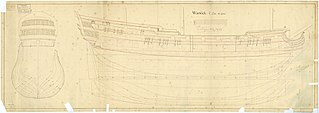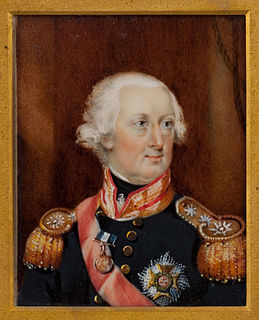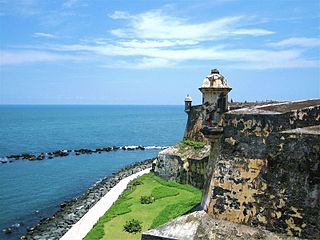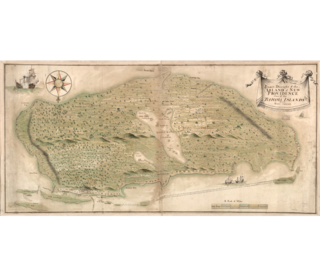
Admiral of the Blue Edward Boscawen, PC was a British Admiral in the Royal Navy and Member of Parliament for the borough of Truro, Cornwall, England. He is known principally for his various naval commands during the 18th century and the engagements that he won, including the siege of Louisburg in 1758 and Battle of Lagos in 1759. He is also remembered as the officer who signed the warrant authorising the execution of Admiral John Byng in 1757, for failing to engage the enemy at the Battle of Minorca (1756). In his political role, he served as a Member of Parliament for Truro from 1742 until his death although due to almost constant naval employment he seems not to have been particularly active. He also served as one of the Lords Commissioners of the Admiralty on the Board of Admiralty from 1751 and as a member of the Privy Council from 1758 until his death in 1761.

Admiral of the Fleet George Anson, 1st Baron Anson, was a Royal Navy officer. Anson served as a junior officer during the War of the Spanish Succession and then saw active service against Spain at the Battle of Cape Passaro during the War of the Quadruple Alliance. He then undertook a circumnavigation of the globe during the War of Jenkins' Ear. Anson commanded the fleet that defeated the French Admiral de la Jonquière at the First Battle of Cape Finisterre during the War of the Austrian Succession.

The Battle of Havana was a naval engagement that took place between the British Caribbean squadron and a Spanish squadron based near Havana during the War of Jenkins' Ear. The battle occurred on the morning of the 12th and ended on 14 October 1748. The belligerents consisted of two squadrons under the command of Admiral Don Andres Reggio of the Spanish Navy and Admiral Sir Charles Knowles of the Royal Navy, respectively. The British succeeded in driving the Spanish back to their harbour after capturing the Conquistador and ran the vice-admiral's ship Africa on shore, where she was blown up by her own crew after being totally dismasted and made helpless. Although the advantage had clearly been with Knowles, he failed to use this to deliver a decisive blow. The battle was the last major action in the War of Jenkins' Ear which had merged with the larger War of the Austrian Succession.

The Battle of Cape Passaro, also known as Battle of Avola or Battle of Syracuse, was a major naval battle fought on 11 August 1718 between a fleet of the British Royal Navy under Admiral Sir George Byng and a fleet of the Spanish Navy under Rear-Admiral Antonio de Gaztañeta. It was fought off Cape Passaro, in the southern tip of the island of Sicily of which Spain had occupied. Spain and Britain were at peace, but Britain was already committed to supporting the ambitions of the Emperor Charles VI in southern Italy.

HMS Raisonnable was a 64-gun third-rate ship of the line of the Royal Navy, named after the ship of the same name captured from the French in 1758. She was built at Chatham Dockyard, launched on 10 December 1768 and commissioned on 17 November 1770 under the command of Captain Maurice Suckling, Horatio Nelson's uncle. Raisonnable was built to the same lines as HMS Ardent, and was one of the seven ships forming the Ardent class of 1761. Raisonnable was the first ship in which Nelson served.

HMS Goliath was a 74-gun third-rate ship of the line in the Royal Navy. She was launched on 19 October 1781 at Deptford Dockyard. She was present at the Battle of Cape St Vincent, Battle of the Nile, and Battle of Copenhagen. She was broken up in 1815.

The siege of Havana was a successful British siege against Spanish-ruled Havana that lasted from March to August 1762, as part of the Seven Years' War. After Spain abandoned its former policy of neutrality by signing the family compact with France, resulting in a British declaration of war on Spain in January 1762, the British government decided to mount an attack on the important Spanish fortress and naval base of Havana, with the intention of weakening the Spanish presence in the Caribbean and improving the security of its own North American colonies. A strong British naval force consisting of squadrons from Britain and the West Indies, and the military force of British and American troops it convoyed, were able to approach Havana from a direction that neither the Spanish governor nor the Admiral expected and were able to trap the Spanish fleet in the Havana harbour and land its troops with relatively little resistance.
HMS Norwich was a 50-gun fourth rate ship of the line of the Royal Navy, launched at Deptford on 24 August 1693.

Sir Charles Knowles, 1st Baronet was a British naval officer who served in the Royal Navy, seeing service during the War of Jenkins' Ear, the wider War of the Austrian Succession, and the Seven Years' War. He also briefly served under the Imperial Russian Navy during the Russo-Turkish War. He rose to the rank of Admiral in a long and varied career, crowned with both success, and at times, controversy.

HMS Warwick was a 60-gun fourth-rate ship of the line of the Royal Navy, built to the 1719 Establishment at Plymouth by P. Lock. The keel was laid down on 1 April 1730, and the ship was launched on 25 October 1733, and completed on 24 August 1734.

Sir Charles Henry Knowles, 2nd Baronet, GCB was an officer of the Royal Navy, who saw service during the American War of Independence, and the French Revolutionary and Napoleonic Wars, eventually rising to the rank of Admiral. He was an extraordinary figure and a great tactical innovator. Highly intellectual, he authored a number of signal books and had the chance to put his ideas into practice during his naval career. Knowles was at times beset by problems with discipline aboard his ships, often due to large proportions of raw recruits and untrained seamen. This may have been a factor in his rocky relationship with his superior, Sir John Jervis, which eventually led to Knowles's retirement from active service after the Battle of Cape St Vincent, and his concentration on scholarly studies of the issues affecting the naval service.

The Battle of La Guaira or La Guayra, took place on 2 March 1743 in the Caribbean, off the coast of La Guaira, present day Venezuela. La Guaira was a port of the Royal Gipuzkoan Company of Caracas, whose ships had rendered great assistance to the Spanish navy during War of Jenkins' Ear in carrying troops, arms, stores and ammunition from Spain to her colonies, and its destruction would be a severe blow both to the Company and the Spanish Government. A British expeditionary fleet under Sir Charles Knowles was defeated, and the expedition ended in failure. 600 men were killed, among whom was the captain of HMS Burford, and many of the ships were badly damaged or lost. Knowles was therefore unable to proceed to Puerto Cabello until he had refitted.
The Battle of Puerto Cabello was an failed attack on a Spanish colonial port during the War of Jenkins' Ear on 16 April 1743.

The invasion of Cuba took place between 4–5 August and 9 December 1741 during the War of Jenkins' Ear. A combined army and naval force under the command of Admiral Edward Vernon and Major-General Thomas Wentworth arrived off Cuba and fortified positions around their landing site at Cumberland Bay. Despite facing no serious opposition, neither commander felt prepared to advance on the Spanish settlement at Santiago de Cuba. Harassed by Spanish raids and with a mounting sick list, the British finally evacuated the island after several months of inactivity.

The Raid on Nassau was a Spanish military expedition that took place in February 1720 during the War of the Quadruple Alliance wherein Spanish forces assaulted the British settlement of Nassau in an attempt to seize the island of New Providence. Although the Spanish managed to raid outlying posts, the assault on Nassau itself was repelled and the invasion was a failure.

Robert Roddam was an officer of the Royal Navy who saw service during the War of the Austrian Succession, the Seven Years' War, and the American War of Independence. He survived to see the French Revolutionary and Napoleonic Wars, but was not actively employed during them.

Charles Inglis was an officer of the Royal Navy who saw service during the War of the Austrian Succession, the Seven Years' War, and the American War of Independence, rising to the rank of rear-admiral.

Lord Augustus FitzRoy was a British officer of the Royal Navy. He served during the War of the Austrian Succession, and was involved in the capture of the Spanish ship of the line, Princesa, a major prize in the war. He was also the father of Augustus FitzRoy, 3rd Duke of Grafton, who became Prime Minister of Great Britain.

The Battle of Saint-Louis-du-Sud, also known as the Battle of Port Louis, was a battle fought in the Austrian War of Succession on 22 March 1748 in the French Caribbean colony of Saint Domingue. A British squadron under the command of Admiral Charles Knowles attacked and destroyed a large French fort under command of French governor Étienne Cochard de Chastenoye.

Le Magnanime was originally a 74-gun ship of the line of the French Navy launched in 1744 at Rochefort. Captured on 12 January 1748, she was taken into Royal Navy service as the third rate HMS Magnanime. She played a major part in the 1757 Rochefort expedition, helping to silence the batteries on the Isle of Aix, and served at the Battle of Quiberon Bay in 1759 under Lord Howe, where she forced the surrender of the French 74-gun Héros. Following a survey in 1770, she was deemed unseaworthy and was broken up in 1775.



















